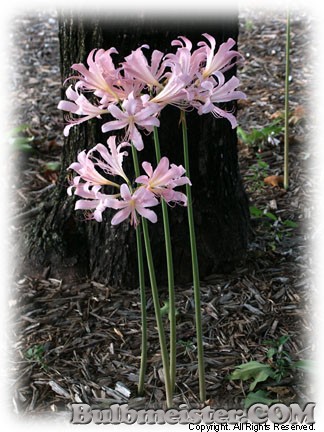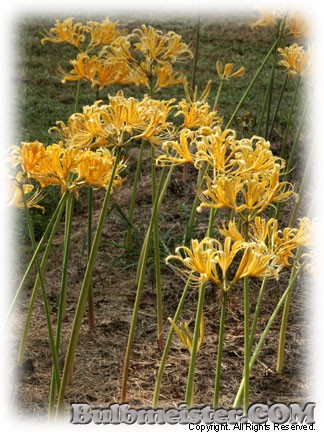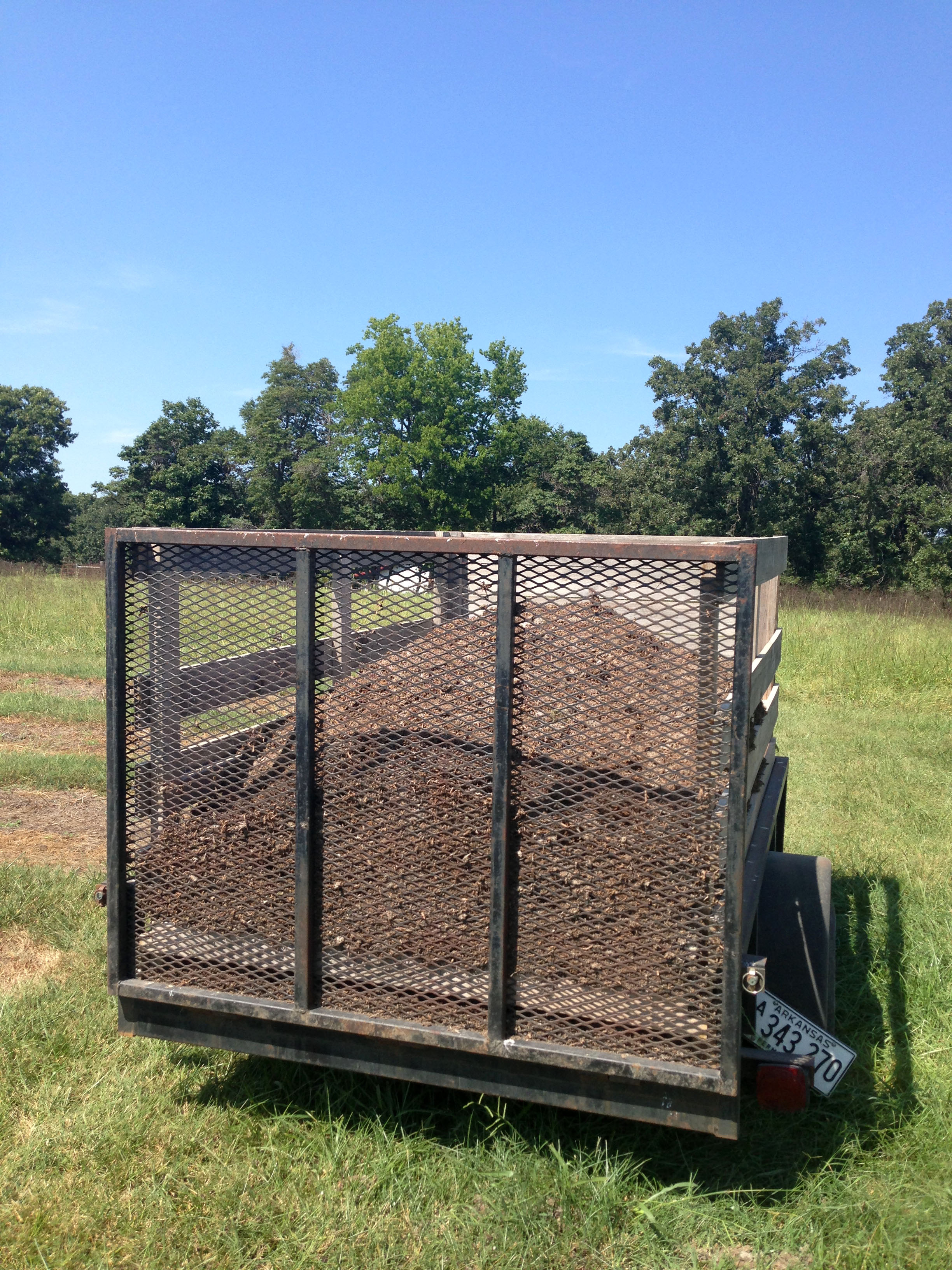Website Modernized
Recognizing that a new format can present new challenges, especially in resolving the technical issues, I'm pleased to announce that Bulbmeister.COM has been simplified and modernized to provide easier navigation. I do hope you will enjoy the new format, and I hope to continue to make improvements, now that I've taken the leap to update the site. Your feedback is much appreciated and can be provided through the updated contact form.
testing usability with latest server update...
 This is just a test.
This is just a test.
2019 Lycoris Seedling Development - One Year Update
 In 2019, I made some Lycoris crosses and also collected bulk open-pollinated Lycoris seed, then I actually followed through and potted all crosses and some otherwise collected. I had not done this for ten years, but, then, only in the last couple did the crosses I had previously made receive enough evaluation to take the next step.
In 2019, I made some Lycoris crosses and also collected bulk open-pollinated Lycoris seed, then I actually followed through and potted all crosses and some otherwise collected. I had not done this for ten years, but, then, only in the last couple did the crosses I had previously made receive enough evaluation to take the next step.
The seeds were planted in 3.5" pots, up to 16 per pot, and in flats, up to a rounded number of 250 per flat. That early winter I put the pots in an outdoor cold frame with supplemental infrared heat. During the winter the electricity tripped a couple of times, and I know I let them get too cold at least once. There was also the burden of manual venting, so I am certain I let them get too hot way too often. I never saw any activity in all the planted seeds, so I expected I had killed the seeds.
In the spring of 2020, after I was venting the frame 100% of the time, I inspected the drain holes at the bottom of the pots, and I carefully "dumped" a few pots to inspect for life, reinserting the soil medium, unbroken, back into the pots. Lo and behold! I found roots and/or bulbs. With this new knowledge, I removed the plastic from the cold frame and covered it with shade cloth for the remainder of the summer.
Enter November! I started noticing a leaf emerging here and there. Having acquired some more reliable (I hope) LED grow lights that promised to use less electricity and put off less heat, I transferred the pots and flats to my growth chamber. Very quickly leaves started to materialize, and the featured photo is how things looked this past Friday, December 11, 2020, approximately one month after transfer.
It is important to note that most of my crosses are spring foliage crosses, and Lycoris in this group generally don't begin to push foliage until early March. The picture of the flats is entirely this type, so, for now, I have to speculate that the current conditions in the growth chamber are encouraging early emergence, OR, things did not go exactly right last Spring, so the seedlings are desperate to accumulate energy. A few of the pots have fall foliage crosses or fall foliage open-pollinated selections, and some of these were the first to show leaves in early November.
Not pictured, because there's nothing to see, yet, are my 2020 crosses and collections, but they went straight into the growth chamber after planting. I am curious to see if any of them give me foliage in the Spring, which would prove to me that my 2019s experienced a measure of duress that may have delayed development. We shall see.
Why Buy Surprise Lilies from the Bulbmeister?
Friends,
 If you enjoy growing flower bulbs in your landscape, you are also likely aware that the more unusual the species, the more costly it can be. So, the wise thing to do is to shop around if you want one. The genus, Lycoris, first entered the United States of America in 1854, so surprise lilies, or spider lilies, have been in the U.S. well over 150 years. Yet, this exceptionally beautiful genus is not experiencing widespread cultivation. I believe the reason is due to the fact that it is not suited well to the average gardener and non-gardener. Why? Foliage growth is not associated with bloom, so the foliage is likely mowed or cut down too early in the spring, and no plant will do well if its source of photosynthesis is cut short over and over, year after year. Lycoris foliage needs to be allowed to begin to “die back” or dwindle before cutting it back to the ground, allowing as many resources for the development, growth, and division of the bulb, as well as encouraging floral initiation.
If you enjoy growing flower bulbs in your landscape, you are also likely aware that the more unusual the species, the more costly it can be. So, the wise thing to do is to shop around if you want one. The genus, Lycoris, first entered the United States of America in 1854, so surprise lilies, or spider lilies, have been in the U.S. well over 150 years. Yet, this exceptionally beautiful genus is not experiencing widespread cultivation. I believe the reason is due to the fact that it is not suited well to the average gardener and non-gardener. Why? Foliage growth is not associated with bloom, so the foliage is likely mowed or cut down too early in the spring, and no plant will do well if its source of photosynthesis is cut short over and over, year after year. Lycoris foliage needs to be allowed to begin to “die back” or dwindle before cutting it back to the ground, allowing as many resources for the development, growth, and division of the bulb, as well as encouraging floral initiation.
There are some very easy solutions to avoid improper care of the foliage in the winter and spring.
- If planting in the lawn, plant around the base of deciduous trees or fixed objects like fences and gas meters, so, that when mowing in the spring, the foliage is more easily avoided, even if hiring out the mowing to folks who wouldn’t know better. Curséd weed wackers! Optionally, intermingle with a daffodil planting, because the leaves from afar don’t look that much different than daffodil leaves, and everybody knows not to cut down daffodil foliage until 6 weeks after bloom, right? Right?
- If planting in a flower bed, again they can be intermingled with daffodils, but they can also be planted under small trees or in other locations where foliage is enhanced by nearby plants that bloom during that same period of time.
Why go to the trouble of growing Lycoris, if you consider the above explanations to be extraordinary efforts?
Of how many flower bulb genera do you know that provide a prominent, colorful, hawk moth & hummingbird attracting bloom anywhere from the end of July onward into October (depending on variety/species)? The answer would be very few. Color! Prominent Color! And flower form can go from “spidery” to “trumpety".
I trust you will agree at this point that surprise lily just might be worth the effort it takes to strategically locate it in your landscape, but price can and should always be a consideration when buying plants for the landscape. Lycoris are significanly more expensive than commonly purchased bulbs like Muscari, Narcissus (daffodils) and tulips, but there’s a good reason for that. A Lycoris bulb takes at least THREE years to develop from seed or scale before it becomes blooming size. So, it, therefore, requires more time in the nursery before it can be presented to you as a blooming size bulb. Time is resources! Time is money! I will note here that vendors who sell Lycoris in pots are selling you a product that will not likely bloom for at least two more years. Dormant importers may sell you a flowering size bulb, but the way it was prepared for transport affects its ability to recover and may still lead to a delay of a couple years, if not more. Essentially, the bulbs really need to still keep their roots during dormancy, and the roots would not survive the long process of import into the U.S.
 So, why buy from Bulbmeister, really?
So, why buy from Bulbmeister, really?
All of my Lycoris are field grown, and I dig the bulbs on demand. This allows me to select flowering size bulbs with roots, and it allows you to receive them in as fresh a condition as possible. That’s not all, though! In addition to supplying a superior product compared to any other vendor, my prices are significantly lower than any of the vendors who offer bulbs with roots in pots (remember, with Lycoris, roots are important). My prices are even comparable and can be better than those more commonly available as dormant imports.
So, when purchasing Lycoris from the Bulbmeister, you get:
- Flowering sized
- With roots
- Fresh as a daisy
- Comparably GREAT prices!
Okay, folks! I’m going to say it. But that’s not all! Here’s the most important conclusion for considering this investment.
Lycoris bulbs are perennial and slowly divide (increase). This means you will be buying a flower bulb that gives and keeps on giving! As a matter-of-fact, it is recommended you dig every 7-10 YEARS to divide and spread out the established mass of bulbs. That’s not because you subscribed to an annual Lycoris delivery service! No way! No how! That’s because you loved and respected the unique qualities of Lycoris, so it rewarded you in return, year after year after year for FREE.
Buy from the Bulbmeister! I try my hardest, relying on nobody else but myself, to provide you a quality addition to your landscape.
As of the time of this writing, my already competitive prices are slashed on most Lycoris (surpise, resurrection, hurricane, magic, spider lily)! These special prices will remain in effect through July 4, 2019. I’ve also included Canna and Zephyranthes in this sale. Please do consider the Bulbmeister, and thank you for your time.
I do have to end with a bit of bad news for some. Due to the fact my bulbs are field grown and do have roots, I am unable to serve the state of California.
The Joys of Mushroom Compost and Math
I have a small 5′ x 8′ landscape trailer I’ve used for over a decade, if not 15 years, to haul all sorts of things, including a leaning tower of computers on a 450 mile journey. It has served me very well all of those years, and I hope to use it for many more. Well, this handy little trailer has specifications allowing it to handle 3500 lbs. of weight. Considering it’s served almost it’s whole life behind my 1995 Kia Sportage, which can only handle 2000 lbs for towing IF the trailer has brakes (and the trailer doesn’t have brakes), it’s not really had to be taxed to it’s limit, until recently. In the last couple of weeks, I’ve moved to towing with my Kia Sorento, able to tow 3500 lbs.
Before I go further, I might mention some facts about the tires on the 14″ wheels. The trailer has two, one on each side, and each is labeled to handle 1290 lbs, meaning together they can carry 2580 lbs. Hmm. So, a trailer weight capacity of 3500 lbs. could lead an engineering and physics novice such as myself to put too much weight on a 3500 lb. capacity trailer, now couldn’t it? Did I mention that these are the original tires that came with the trailer? Well, they are, and though they still have great tread, and the spare has never been used, I’m sporting tires composed of at least 10-year-old materials.
Last year I decided to drive 64 miles to Miami, OK (NOT Florida), to haul home some mushroom compost for my garden, and I did this in the Sportage. You see, the cheapest price I could find for delivery was $45/yard, and it could be bought directly for $15/yard. When I got there, I had determined that, by volume, my trailer (with walls added) could handle about 3 yards of compost. As a matter of fact, I figured it could handle four, by volume, but not knowing actual weight, I stuck with three yards. I paid for three and drove around to the loading pad where the Bobcat driver promptly loaded one… two…
“WHOA! STOP!!” I cried. My tires were almost flat to the ground, and I was panicking! I got out my tire gauge, and the tires (I hadn’t used the trailer in a season), were down to 20 lbs., not up to 35 lbs., their maximum. I stopped the loader from providing the third paid load and crippled away with two loads for the price of three. I turned into the nearest air station, found enough quarters, and filled the tires to about 30 lbs. The tires, though looking a bit stressed, looked okay, and I carefully drove home.
Enter two weeks ago. This time I needed the compost for my nursery, and I used the Sorento. This time I checked the tire pressure (as I should have done the first time) and aired up all the way to maximum allowed, and, this time, I was pretty sure I could handle three yards. I drove 64 miles, paid for three yards, drove around to the loading pad where the Bobcat driver promptly loaded one… two…
“WHOA! STOP!!” I blustered. My tires didn’t look like they could handle another load! Maybe this driver had loaded the bucket more heavily? I don’t know for sure why it looked worse than the previous time (with proper tire pressure), but, nevertheless, again I slowly limped away with two loads for the price of three, and I carefully drove home.
“Maybe I should do some research,” I thought to myself.
One, can I get tougher tires? YES! I can purchase a tire that can handle 1760 lbs. (and still fit my fenders), or two for 3520 lbs.! Well, that almost EXACTLY matches the capacity of the trailer! Oh, but I’m going to be away when the order would arrive, so I will have to delay adding new tires until I get back. Good. To. Know.
Two, just what does a yard of mushroom compost weigh? Well, a yard can be up to 600 lbs. Wow! Still, If I only get 3 yards, that would only be 1800 lbs., right? Why do my tires look so stressed? Oh, well. I’d better, for the time being, just stick with two yards. Maybe the tires are showing their age.
Enter today! Following the scenario of two weeks past, I drove around to the loading pad where the Bobcat driver promptly loaded one… two-three!!!!!
“Arrrgghhh!! STOP!! I only purchased two,” I hastened.
“Oh, I’ll give you as much as you want,” he said with a smile. “These buckets hold 1 1/2 yards, so you should have about 4 1/2 yards in there right now.”
My 10-year-old tires are looking mighty sad, and I am, too, right about now as I give the Bobcat driver my gracious thanks, while, at the same time my heart goes into palpitations. “How am I going to make the 64 mile trip home?” I mused. “At least I now know why my tires looked so stressed last time.” I then, under my breath, honestly asked God to get me home with special attention to my safety and others’. Here, at home, safe and sound I write, less than two hours after returning. Attribute my safe return at your own discretion, but it is as it is.
Somehow, with only the ability to haul 2580 lbs., my tires hauled, today, at least 2700 lbs. of compost plus trailer weight, which I imagine to be around 300 lbs. The leaf springs under the trailer, two inches from the axle when not loaded, were about one inch from the axle. After all, they could have handled 500 more pounds, if it weren’t for my tire limitations.
So, now that I know how much is actually loaded from their Bobcat bucket, one-and-a-half yards, and not one yard, I know that, over the life of this witness, I paid for eight yards of compost and drove out with 10 1/2 yards, getting a better bargain than I could have imagined. J-M Farms, Inc., is a great place to buy mushroom compost! Not only is the current going price of $15/yard a bargain, they are intentionally generous by attributing one yard to a one-and-a-half yard bucket. Don’t go there expecting them to load extra buckets, by the way. They had a lot of compost, and concerning a line of customers for pickup, the crickets were singing today. This is not their usual scenario. I love, however, their standard scenario, as the philosophy does it’s best to provide more than required.
Why write about this? Therapy. My heart rate has gone back to a normal hop, skip, and jump. Time to prepare more flower bulb beds for transplanting!
:: Next >>

